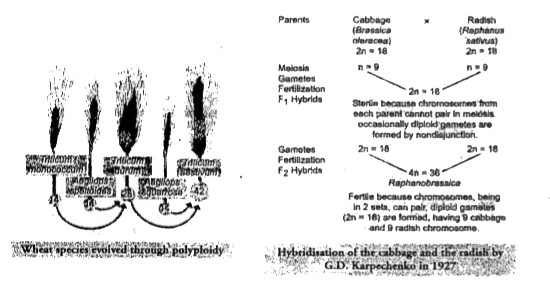Define Speciation. How does a species originate gradually as well as abruptly? Explain.
Text Solution
The process of the formation of one or more new species from the existing one by evolutionary is known as speciation.
Method of Speciation.
Members of a species seldom live together as a single large population. Gencrally, a species exists as small interbreeding populations termed demes. The demes may occupy adjacent or far off regions. Widely separated demes may face varied environmental conditions. Mutation and selection in the isolated populations may produce sufficient phenotypic variation to form new speices.
Types of Speciation
Speciation is of 3 main types :-
I. Multiplicative Speciation (Cladogenesis). A parent species buds of one or more species and itself continues to cxist. The process is called multiplicative speciation as it increases the number of species. It is the most common mode of speciation. It is further of iwo types: gradual and instant.
A. Gradual Speciation. It occurs through population and spans over many generations. It is of 2 types -
(i) Allopatric Speciation. It takes place with geographic isolation. It involves subdivision of original population with the formation of a geographical barrier, such as a mountain or land bridge (e.g., Isthmus of Panama) or ocean, across the species range.
(ii) Sympatric Speciation. It occurs without geographic isolation, that is, by ecological or other isolations. It produces new species within a single population. It may result from polyploidy.
B. Instant Speciation. It occurs through individuals and in a single generation by hybridization involving allopolyploidy (described ahead).
Members of different species usually do not produce fertile offspring by imerorccuiug. Occasionally, the individuals of two different but closcly related species may interbreed to produce fertile young ones. In such a case, the offspring represent a new species as they are reproductively isolated from their parents, i.e., cannot mate with them. Hybridization may combine the best traits of both the parent species into the new species, giving the latter .better chances of survival than either of its parents. If the new species combined the worst characters of both parents, it would be at a great disadvantage and would be unlikely to survive.
When individuals of different species having different chromosome numbers are mated, the offspring are usually sterile. The reason is that the unlike chromosomes cannot pair in meiosis, and Evolution the gameles do not receive the full chromosome complement, one of cach kind. Is in an interspecific hybrid, the number of chromosomes becomes double by a form of chromosome mutation called allopolyploidy, mciosis can occur and normal gametes formed. Then the hybrid species will breed true and get established.

That new species instantly arise in nature by .hybridization and doubling of chromosomes is supported by experimental formation of new species Raphanohrassica with 36 chromosomes by LOSsing radish (Raphanus) and cabbage (Brassica), each with 18 chromosomes (Fig.). Many related species of higher plants have chromosome numbers which are multiples of same basic number. In wheat, there are species, with 14,28 and 42 chromosomes, in rose, there are species with 14,28,42 and 56 chromosomes.
II. Phyletic Speciation. Replacement of one species by another without an increase in the number of species is termed phyletic speciation. Example: Eohippus cvolved into Mesohippus and itself became extinct.
Phyletic speciation is also called anagenesis.
III. Speciation by Fusion. Occasionally two distinct species merge into one new species by breakdown of previously existing reproductive isolation, leading to reduction in the total number of species.
|
Topper's Solved these Questions
- EVOLUTION BOOK - BETTER CHOICE PUBLICATIONCHAPTER - EVOLUTION EXERCISE - LONG ANSWER TYPE QUESTIONS (5 Marks) (MOST EXPECTED QUESTIONS)
13 Videos
- EVOLUTION BOOK - BETTER CHOICE PUBLICATIONCHAPTER - EVOLUTION EXERCISE - SHORT ANSWER TYPE QUESTIONS (3 Marks) (MOST EXPECTED QUESTIONS )
9 Videos
- ENVIRONMENTAL ISSUES BOOK - BETTER CHOICE PUBLICATIONCHAPTER - ENVIRONMENTAL ISSUES EXERCISE - LONG ANSWER
43 Videos
- HUMAN HEALTH AND DISEASEBOOK - BETTER CHOICE PUBLICATIONCHAPTER - HUMAN HEALTH AND DISEASEEXERCISE - LONG ANSWER TYPE QUESTIONS (MOST EXPECTED QUESTIONS)
12 Videos
Similar Questions
How do new species originate in nature ?
View SolutionWhat is speciation? How does it occur?
View SolutionExplain how does vaccine work?
View SolutionHow does Mandela define the brave?
View SolutionDefine 'Species'. How human species are differentiated from each other?
View SolutionDefine electronegativity. How does it vary in the periodic table?
View SolutionDefine fermentation. How does it differ from anaerobic respiration? Explain.
View SolutionDefine an orbital . How does it differ from an orbit ?
View SolutionDefine reproduction. How does it help in providing stability to the population of species ?
View SolutionDefine reproduction. How does it help in providing stability to the population of species ?
View Solution
